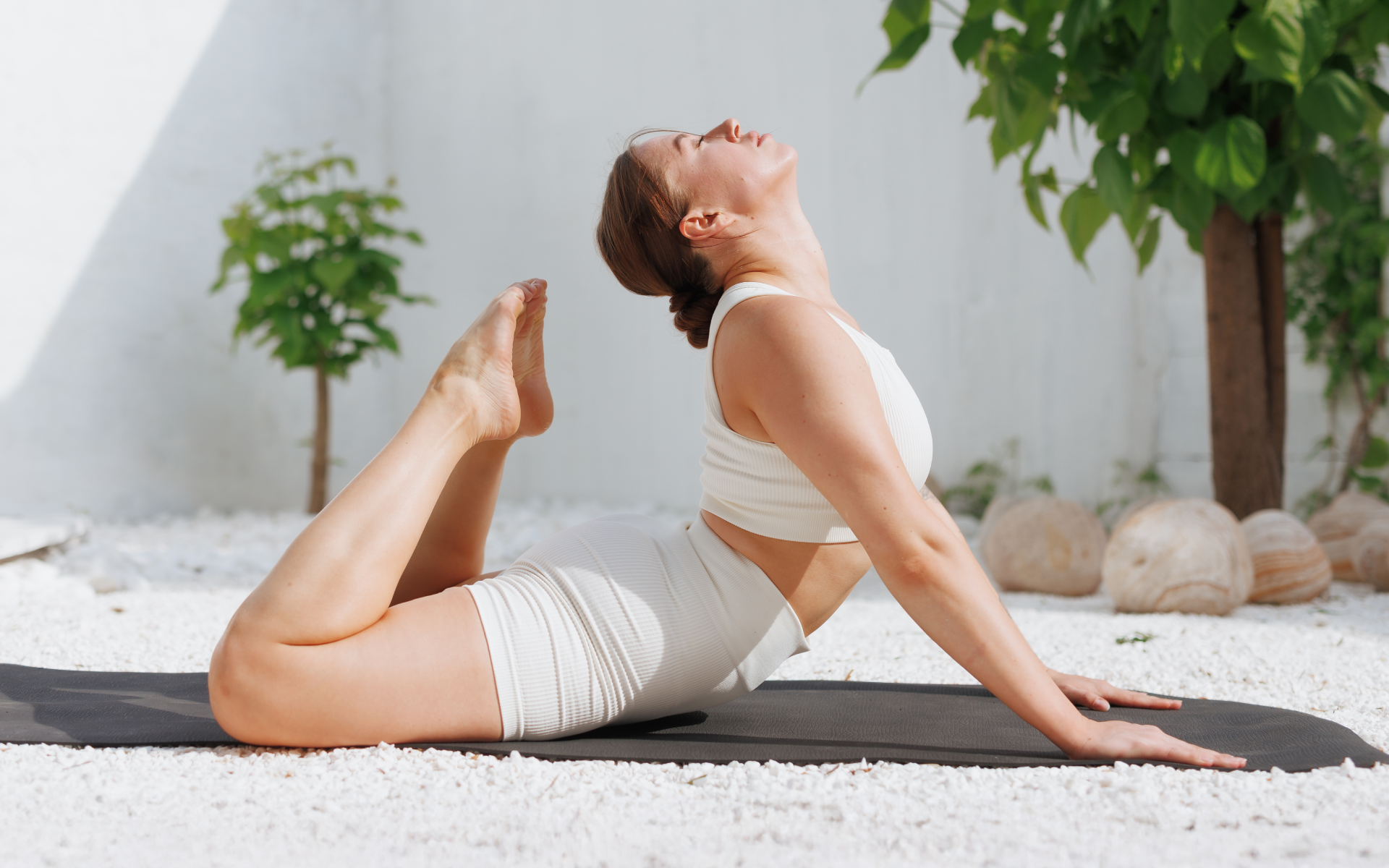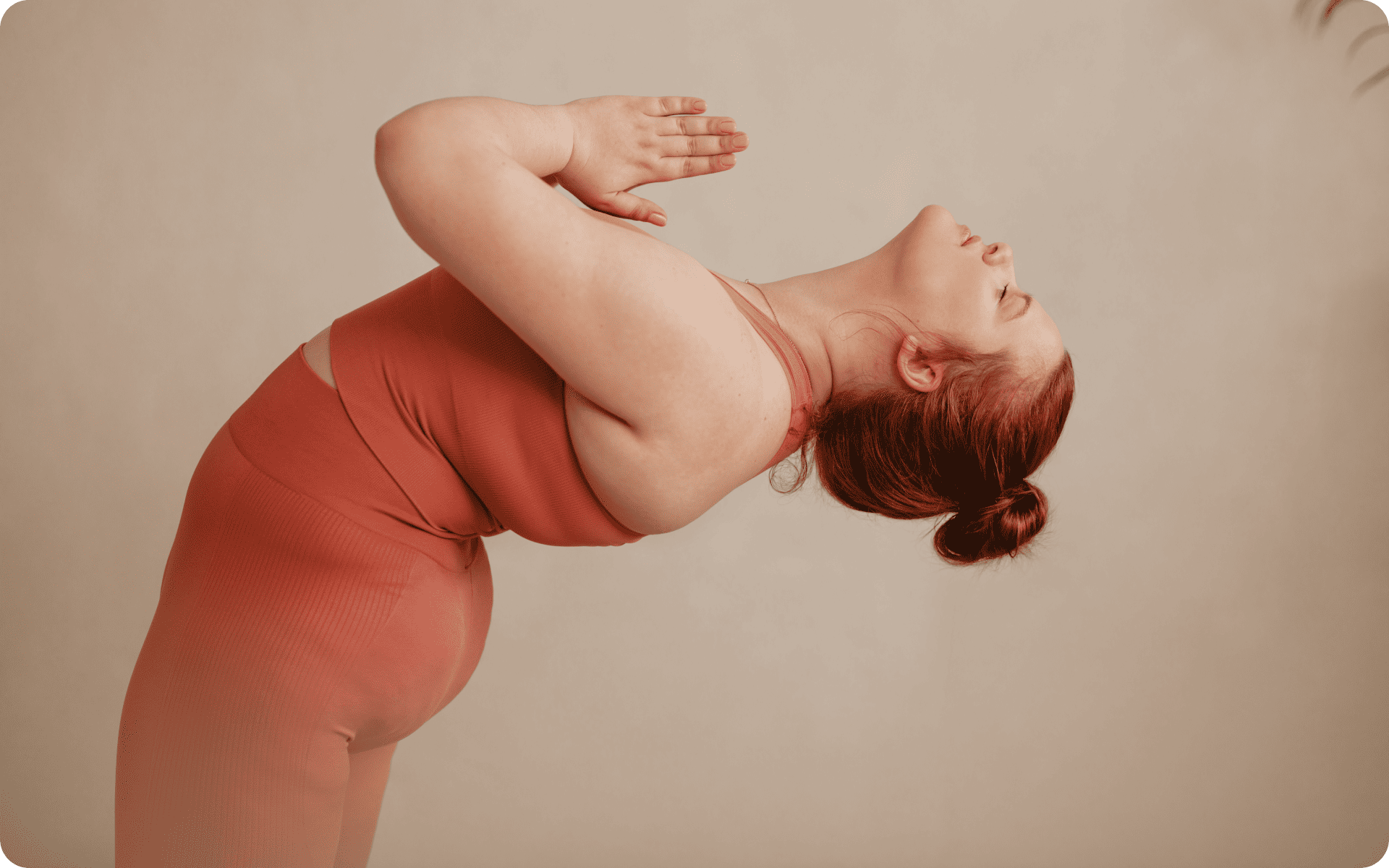In a world that thrives on moving fast, finding peace has become an elusive task. Stress has increased in our lives at an alarming rate, sometimes arising due to factors that may not even be in our control. In just 12 years, anxiety and depression have become increasingly prevalent among young adults in the US, with both disorders increasing by 63% from 2005 to 2017 (1). While the numbers continue to rise, the answer to our current mental health concerns may be rooted in the past. With its origins in ancient India, Japa yoga is a simple yet deeply effective practice. It’s accessible to anyone seeking clarity and serenity amidst the chaos of everyday life.
Now imagine this: A single word holding the power to transform your mind, calm your spirit, and connect you to something greater than yourself. Sounds too good to be true? This is the essence of Japa yoga, where the repetition of a sacred mantra becomes a gateway to inner peace and spiritual growth.
Contrary to other forms of yoga that focus on physical postures and breath control, Japa yoga is centered entirely on the mind. By repeating a chosen mantra—aloud, in a whisper, or silently within—the practitioner gradually quiets the endless chatter of the mind and cultivates a profound sense of stillness.
Through this article, we’ll take you into the depths of Japa yoga. We give you all the information you’ll need to practice this divine method.
Understanding Japa Yoga
What Is Japa Yoga?
As Swami Sivananda explains it, Japa yoga is a spiritual practice centered on the repetition of a mantra. These mantras are believed to invoke divine power. Practiced either silently or audibly, this powerful form acts as a means to focus the mind and create spiritual awareness. The essence of Japa lies in its ability to lead practitioners toward deep meditation and eventually to a state of Samadhi, or communion with God (2).
But before we proceed, it’s important to understand the meaning of the words in order to better understand the concept. The word “Japa” means “muttering” or “repetition” and it typically involves the continuous recitation of sacred words or phrases. It can be traced back to the ancient language of Sanskrit.
According to Swami Sivananda, “Japa must become habitual and must be attended with Sattvic Bhava (divine thought), purity, Prem (love), and Sraddha (respect).” This practice is considered to be a powerful tool for attaining mental clarity, concentration, and ultimately, self-realization.
In its essence, Japa yoga is about creating a rhythmic connection between the mind and the sound vibrations of the chosen mantra. This repetitive prayer or meditation helps redirect the mind from its habitual patterns of thought to a higher state of consciousness – ultimately promoting a profound sense of inner peace and connection with the divine (3).
The History and Origins of Japa Yoga
Japa yoga has its roots deeply in the ancient spiritual traditions of India, with references found in the Vedas and the Bhagwad Gita, which date back over 3,000 years. These sacred texts emphasize the power of sound and vibration, with mantras being used as tools to invoke divine energies (4).
The practice of Japa is also closely linked to Bhakti yoga, which emphasizes devotion and the remembrance of the divine (5). Historically, Japa was a means to maintain spiritual discipline, particularly in monastic settings. There, monks would dedicate their lives to the repetition of mantras as a path to enlightenment. Over time, this learning spread beyond the monasteries and became a fundamental aspect of daily spiritual practice for many.
https://cdn.betterme.world/articles/wp-content/uploads/2024/07/3-1.png
The Philosophy Behind Japa Yoga
The philosophy of Japa yoga is deeply intertwined with the concept of sound and vibration as fundamental forces in the universe. In a nutshell, the philosophy behind Japa yoga can be seen as follows (6):
- Vibrational Foundation: Japa yoga is based on the idea that the universe, which includes thoughts and emotions, is composed of vibrations. Mantras are seen as powerful vibrational tools that can purify the mind and body, aligning the practitioner with divine frequencies.
- Sacred Sounds: Mantras in Japa yoga are not just words but sacred sounds that invoke divine presence, helping practitioners transcend ego and mundane thoughts.
- Spiritual Goal: The ultimate aim of Japa yoga is to achieve Samadhi, a state of spiritual enlightenment where one experiences unity with the divine. This practice aligns closely with Bhakti yoga, which emphasizes devotion and continuous remembrance of the divine.
- Harmonizing Consciousness: Through mantra repetition, Japa yoga harmonizes individual consciousness with universal consciousness, fostering deep spiritual growth and self-realization.
Read more: Body Awareness: Understanding and Practicing Mindful Connection with Your Body
Importance of Mantras in Japa Yoga
Mantras are the cornerstone of Japa yoga. These sacred sounds aren’t considered merely words; they’re meant to be a direct embodiment of divine energy. Each mantra has a specific meaning and vibrational frequency that aligns the practitioner with different aspects of the divine.
For example, the mantra “Om” is believed to be the primordial sound of the universe, taking into its fold, the essence of all creation. Repeating “Om” during Japa yoga helps harmonize the mind with the universal consciousness, which fosters a sense of unity and oneness with all that exists (7).
Other common mantras include “So’ham”, which translates to “I am that”, signifying the identification of the self with the ultimate reality. The constant repetition of such mantras calms the mind and deepens the practitioner’s spiritual awareness, paving the way for profound inner transformation.
Benefits of Japa Yoga
Physical Benefits
While Japa yoga is primarily known for its spiritual and mental benefits, it also offers significant physical advantages, including:
- The repetitive nature of mantra chanting helps regulate breathing patterns, which can lead to improved respiratory function and enhanced cardiovascular health (8).
- Regular practice of Japa yoga has been shown to lower blood pressure, reduce heart rate, and alleviate symptoms of chronic illnesses by promoting relaxation and reducing stress levels (9).
- Furthermore, the deep, rhythmic breathing involved in Japa yoga enhances oxygenation of the body’s tissues, thereby, contributing to better overall physical health. This practice can also improve posture, as the act of sitting upright during Japa meditation strengthens the spine and enhances bodily alignment (10).
Mental and Emotional Benefits
Japa yoga offers significant mental and emotional benefits. Repeating a mantra helps you focus your mind, quiets mental noise, and allows you to concentrate more deeply. Such a focused approach can reduce stress, anxiety, and depression by shifting your thoughts away from worry and fear and bringing you to a place of peace and clarity (10).
Emotionally, practicing Japa yoga can make you feel more content and joyful. The positive energy from chanting mantras can lift your mood, boost your sense of well-being, and help you stay emotionally balanced (11). Over time, many people find they have become more resilient and are better able to handle life’s challenges.
BetterMe: Meditation & Sleep app can help you transmute stress into serenity, pull you up from the doldrums, free your mind from the cares and worries of the world, quell racing thoughts and infuse you with tranquility! Start using it now and change your life!
Spiritual Benefits
At its heart, Japa yoga is a spiritual practice that aims to help you connect with your true self and the divine.
- Repeating mantras over and over cleanses and eases the mind, removes negative thoughts, and encourages spiritual growth.
- As you go deeper into the practice, you may experience higher states of awareness, moments of divine insight, and a strong sense of unity with the universe.
- This spiritual path can also sharpen your intuition and open you up to inner wisdom. By tuning into the vibrations of the mantras, you may become more aware of the deeper aspects of life, gaining insights that go beyond everyday understanding.
How to Practice Japa Yoga
Choosing a Mantra
Selecting the right mantra is the most important step in the Japa yoga practice. This chosen mantra should resonate with the practitioner on a deep level and reflect their spiritual goals and personal beliefs. Traditionally, a guru or spiritual teacher would assign a mantra to the disciple to make sure it’s best suited to their specific needs and spiritual aspirations.
For beginners, simple mantras such as “Om” or “So’ham” are most often recommended. These universal mantras are easy to remember and have powerful effects. As you advance in your practice, you may choose more complex mantras that align with specific deities or spiritual concepts, such as “Om Namah Shivaya” (I bow to Shiva) or “Om Mani Padme Hum” (The jewel is in the lotus).
How to Select a Mantra for Yourself
- To choose a mantra for yourself, reflect on your personal spiritual goals, understand your affinity with particular deities or concepts, and seek the guidance of a spiritual teacher if possible.
- Once selected, it’s important to stay committed to the chosen mantra to fully experience its transformative power.
- The shorter the mantra you select, the greater will be your concentration levels.
- Repeating the mantra should be done with devotion and focus, either silently or aloud, depending on the method that resonates most with you.
Techniques for Practicing Japa Yoga
There are several techniques for practicing Japa yoga, each with its unique benefits and levels of intensity. The 3 most common methods include (6):
- Manasic Japa (Mental Japa): This technique involves silently repeating the mantra in your mind. It is considered the most powerful form of Japa yoga as it requires deep concentration and mindfulness. This method is ideal for practitioners who have developed a certain level of mental discipline and are seeking to deepen their meditation practice.
- Vachika Japa (Audible Japa): In this method, the mantra is chanted aloud. The vibrations of the spoken mantra can have a soothing effect on the practitioner and those around them. Audible Japa is particularly effective in group settings or when the practitioner needs to maintain focus amidst distractions.
- Upamsu Japa (Whispered Japa): This technique involves whispering the mantra so softly that only the practitioner can hear it. It serves as a bridge between mental and audible Japa, combining the benefits of both methods.
Tools and Props for Japa Yoga
Although Japa yoga works on the principle of chanting, there exist certain props and tools that can help in the process of developing focus. The most common are the mala or prayer beads and a Japa book.
Mala
A mala typically consists of 108 beads, which are used to count the repetitions of the mantra. The beads serve as a tactile reminder of the practice, helping to anchor the mind during meditation.
Mala beads are not just a counting tool, they also symbolize the cyclical nature of the universe and the journey of self-discovery. It is a sacred instrument that holds a lot of power in the practice of Japa yoga (12).
Malas can be made from different materials such as wood, seeds, pearls, semi-precious stones, bone, and ivory. The most common materials are sandalwood, rudraksha seeds, tulsi seeds (holy basil), lotus seeds, bodhi seeds, rosewood, and crystal.
- To use a mala effectively, hold it in your right hand, allowing it to rest on your middle finger.
- Start at the bead next to the guru bead, and use your thumb to pull each bead towards you as you recite the mantra.
- This physical action helps maintain focus and keeps your mind from wandering.
Japa book
Another useful tool is a Japa book or diary where practitioners can record their experiences, insights, and the number of mantras recited each day. This helps with tracking progress and deepens the practitioner’s connection to the practice, standing as a testament to their dedication.
Integrating Japa Yoga into Your Daily Life
1. Getting Started with Basic Practices
You don’t need to make huge changes to integrate Japa yoga into your daily routine; just a few minutes each day can make a big difference. Start by setting aside a specific time for your Japa practice. Many people find that the morning is an ideal time, as the mind is naturally calmer and more open. But really, you can adapt the practice to any time that works best for you.
To begin, find a quiet and comfortable spot where you won’t be disturbed. Sit in a relaxed position with your spine straight, close your eyes, and start chanting your chosen mantra. Allow the sound and vibration of the mantra to fill your mind completely.
2. Creating a Daily Routine
Consistency is key to experiencing the full benefits of Japa yoga. Establishing a daily routine helps make the practice a regular part of your life. You can start with just 5 to 10 minutes a day and gradually increase the time as your focus improves.
Incorporating Japa yoga into your morning routine is a great way to start the day with clarity and calm. Here’s an example of a simple daily routine:
- Morning: When you wake up, spend 5-10 minutes in Japa meditation, focusing on your chosen mantra to set a peaceful tone for the day.
- Midday: Take a 3-5 minute break during the day to practice silent Japa, helping you stay centered amidst your activities.
- Evening: Before bed, practice another 10 minutes of Japa to calm your mind, reflect on your day, and prepare for a restful sleep.
3. Combining Japa Yoga with Daily Activities
Japa yoga can easily be included in other parts of your day:
- You can practice Japa while walking, cooking, or even during your commute. This is known as Ajapa Japa, where you mentally repeat the mantra throughout your everyday activities, turning them into opportunities for spiritual practice (6).
- You can also combine Japa with other forms of yoga, such as Hatha or Bhakti yoga, to deepen your spiritual practice and amplify the overall benefits (6).
Practical Tips and Guides
Sample Japa Yoga Sequence
A typical Japa yoga session may start with a few minutes of deep breathing to center your mind, followed by chanting your mantra for a set number of repetitions. Here’s a simple sequence to get you started:
- Find a quiet and comfortable place to sit.
- Close your eyes and take a few deep breaths.
- Begin chanting your chosen mantra, either silently, audibly, or in a whisper.
- Use a mala to keep track of your repetitions.
- After completing your repetitions, sit quietly for a few moments to absorb the energy of the practice.
Meditation and Breathing Exercises
Combining Japa yoga with meditation and breathing exercises can really help improve your practice.
Pranayama, such as Nadi Shodhana (alternate nostril breathing), is particularly effective for calming the mind and preparing you for Japa meditation. You can move straight from Pranayama into your Japa session (13).
When you’re done with your Japa practice, you may want to sit in silent meditation, focus on your breath, or look more closely at your thoughts, to settle into a state of deeper awareness.
Using Mala Beads in Japa Yoga
Mala beads are a helpful tool for many Japa yoga practitioners. They help you keep track of your repetitions and stay focused. To use a mala (14):
- Hold the mala in your right hand, letting it rest on your middle finger.
- Start at the bead next to the larger guru bead, using your thumb to pull each bead toward you as you recite your mantra.
- When you reach the guru bead, pause and reflect, then continue in the opposite direction if you wish to keep going.
This physical process helps keep your mind focused during meditation, which makes it easier to stay present and engaged.
Overcoming Challenges in Japa Yoga
1. Staying Motivated
One of the foremost challenges with Japa yoga is remaining motivated. When life gets busy or the mind becomes cluttered and restless, the first thing many people end up doing is abandoning their practices.
To keep things fresh, try varying your mantras or the method of Japa you use. Setting small, manageable goals, like committing to just five minutes a day, can help you stay motivated.
2. Handling Distractions
Distractions are a normal and natural part of Japa yoga. When this happens, gently bring your focus back to the mantra. Remember, it’s common for the mind to wander, and each time you bring it back, you’re only strengthening your concentration.
Setting up a dedicated space for practice that is free from interruptions can also help minimize distractions.
3. Managing Time and Commitment
Finding time for Japa yoga in a busy schedule can be challenging, but even a few minutes each day can make a big difference. It’s best to start with short sessions and increase the time as your practice deepens.
Incorporating Japa into your existing routines, such as your morning walks or evening rituals, is another practical way to help you stay consistent. Setting reminders or scheduling your Japa sessions into your routine consistently can also help you manage your commitment.
FAQs
What’s the best way to start practicing Japa yoga?
The best way to start is by choosing a simple mantra such as “Om” or “So’ham” and setting aside a few minutes every day for practice. Find a quiet spot where you can focus without interruptions, and start chanting your mantra, either silently or aloud. As you get more comfortable, you can gradually extend the duration of your practice.
Can anyone practice Japa yoga regardless of age or fitness level?
Yes, Japa yoga is suitable for people of all ages and fitness levels. Unlike more physically demanding forms of yoga, Japa yoga is a meditative practice that doesn’t require any special physical abilities. You can practice it while seated, lying down, or even walking. This makes Japa yoga easily accessible and a versatile and inclusive practice.
How is Japa yoga different from other forms of yoga?
Japa yoga is distinct as it focuses primarily on the repetition of mantras rather than physical postures or breath control. While it shares elements with other types of yoga, such as concentration and meditation, its use of sound as the primary means of spiritual practice sets it apart.
What should I expect from a Japa yoga session?
A typical session involves repeating your chosen mantra, either mentally or aloud, for a set period or number of repetitions. The session might start with a few minutes of deep breathing or Pranayama, followed by chanting the mantra. It’s common to sit in silence for a few moments afterward to absorb the effects of the practice.
How often should I practice Japa yoga?
For the best results, try to practice Japa yoga daily. Even a short session each day can lead to significant benefits over time. The key is consistency, so find a routine that works for you and stick with it.
The Bottom Line
By including Japa yoga in your daily routine, you’re likely to experience the profound physical, mental, and spiritual well-being that’s hard to find in today’s fast-paced world. Rooted in ancient sciences, this yogic practice is a powerful way to cultivate inner peace and clarity and to form a deeper connection with nature and the divine. Whether you’re looking for stress relief, spiritual growth, or a greater sense of purpose, Japa yoga can be your one-stop solution toward lasting fulfillment.
DISCLAIMER:
This article is intended for general informational purposes only and does not serve to address individual circumstances. It is not a substitute for professional advice or help and should not be relied on for making any kind of decision-making. Any action taken as a direct or indirect result of the information in this article is entirely at your own risk and is your sole responsibility.
BetterMe, its content staff, and its medical advisors accept no responsibility for inaccuracies, errors, misstatements, inconsistencies, or omissions and specifically disclaim any liability, loss or risk, personal, professional or otherwise, which may be incurred as a consequence, directly or indirectly, of the use and/or application of any content.
You should always seek the advice of your physician or other qualified health provider with any questions you may have regarding a medical condition or your specific situation. Never disregard professional medical advice or delay seeking it because of BetterMe content. If you suspect or think you may have a medical emergency, call your doctor.
SOURCES:
- The Rise of Anxiety and Depression Among Young Adults in the United States (2021, ballardbrief.byu.edu)
- Japa Yoga (n.d., sivanandaonline.org)
- An overview of Japa-Yoga research for health and well-being (2018, researchgate.net)
- Explore The Ancient Roots of Yoga (n.d., artsandculture.google.com)
- How japa Changed between the Vedas and the bhakti Traditions (2012, researchgate.net)
- Japa Yoga: A comprehensive treatise on mantra-sastra (2010, japa-yoga.org)
- Meditation On The Power Of Om (n.d., articles.sivananda.org)
- Effect of Bhramari pranayama and OM chanting on pulmonary function in healthy individuals (2014, ncbi.nlm.nih.gov)
- Effect of Ajapa Japa on Stress (2013, ijcrt.org)
- Scientific Approaches Of Yoga (2019, mis.alagappauniversity.ac.in)
- Positive Effects of ‘AUM’ Chanting on Mental Health Well-Being (2023, traditionalmedicines.org)
- Overcoming Spiritual Darkness: The Practice of Japa (n.d., yogainternational.com)
- Nadi Shodhan Pranayama (Alternate nostril breathing) (n.d., artofliving.org)
- How to Use a Mala (2023, wikiHow.life)











